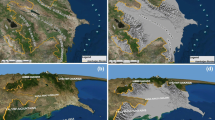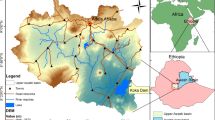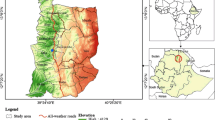Abstract
In the last 30 years, the growth of the agriculture and livestock industries in the Cerrado biome has caused severe changes in land use and land cover (LULC), and areas previously occupied by native vegetation are changing to agricultural monocultures (e.g., soybean or corn) and/or pastures. Thus, the objective of this study was to analyze the LULC changes for the years 1986, 1999, 2007, and 2016 based on Landsat time series and object-based image analysis (OBIA) for the Prata River Basin. Twelve LULC classes were mapped: riparian forest, cerrado, swampy grasslands, wetlands, semideciduous forest, pasture, agriculture, fallow agricultural land, barren land, eucalyptus, water bodies, and burnt area. The classifications presented results with an overall accuracy of more than 93% and a kappa coefficient of 0.92. In 2007, the pasture class had the highest increase in area (48.5%), with a total area of 118.32 km2 of Cerrado biome vegetation converted to pasture, and the classes banhado, riparian forest, swampy grasslands, and cerrado had the greatest reductions in area (41.58%, 29.67%, 25.44%, and 21.63%, respectively). More precisely, the wetlands class underwent the greatest decrease under the advancement of pasture in the studied period (− 36.2%). These changes are due to factors favorable to agropastoral practices, such as a flat relief and soil with good agricultural suitability.

Graphical abstract







Similar content being viewed by others
References
Achard, F., Beuchle, R., Mayaux, P., Stibig, H. J., Bodart, C., Brink, A., Carboni, S., Descle, B., Donnay, F., Eva, H. D., Lupi, A., Raši, R., Seliger, R., & Simonetti, D. (2014). Determination of tropical deforestation rates and related carbon losses from 1990 to 2010. Global Change Biology, 20, 2540–2554. https://doi.org/10.1111/gcb.12605.
Aggarwal, N., Srivastava, M., & Dutta, M. (2016). Comparative analysis of pixel-based and object-based classification of high resolution remote sensing images—A review. International Journal of Engineering Trends and Technology (IJETT), 38, 5–11.
Anache, J. A. A., Flanagan, D. C., Srivastava, A., & Wendland, E. C. (2018). Land use and climate change impacts on runoff and soil erosion at the hillslope scale in the Brazilian Cerrado. Science of the Total Environment, 622–623, 140–151. https://doi.org/10.1016/j.scitotenv.2017.11.257.
Anderson, J. R., Hardy, E. E., Roach, J. T., & Witmer, R. E. (1976). A land use and land cover classification system for use with remote sensor data. Geological Survey Professional Paper, 964, 34.
APROSOJAMS - Associação dos Produtores de Soja do Mato Grosso do Sul. (2019). http://sistemafamasul.com.br/aprosoja-ms/a-aprosoja-ms/. Accessed 22 June 2019.
Aslami, F., & Ghorbani, A. (2018). Object-based land-use / land-cover change detection using Landsat imagery : a case study of Ardabil , Namin and Nir counties in northwest Iran. Environmental Monitoring and Assessment, 190(7), 376. https://doi.org/10.1007/s10661-018-6751-y.
Bacani, V. M., Sakamoto, A. Y., Quénol, H., Vannier, C., & Corgne, S. (2016). Markov chains–cellular automata modeling and multicriteria analysis of land cover change in the lower Nhecolândia subregion of the Brazilian Pantanal wetland. Journal of Applied Remote Sensing, 10, 016004. https://doi.org/10.1117/1.JRS.10.016004.
Beuchle, R., Grecchi, R. C., Shimabukuro, Y. E., Seliger, R., Eva, H. D., Sano, E., & Achard, F. (2015). Land cover changes in the Brazilian Cerrado and Caatinga biomes from 1990 to 2010 based on a systematic remote sensing sampling approach. Applied Geography, 58, 116–127. https://doi.org/10.1016/j.apgeog.2015.01.017.
Congalton, R. G., Green, K., Group, F., & Raton, B. (2009). Assessing the accuracy of remotely sensed data—Principles and practices. International Journal of Applied Earth Observation and Geoinformation, 11, 448–449. https://doi.org/10.1016/j.jag.2009.07.002.
Definiens. (2006). Definiens professional 5 : Reference book (p. 122). Munich: The Imaging Intelligence Company.
Dou, J., Li, X., Yunus, A. P., Paudel, U., Chang, K. T., Zhu, Z., & Pourghasemi, H. R. (2015). Automatic detection of sinkhole collapses at finer resolutions using a multi-component remote sensing approach. Natural Hazards, 78, 1021–1044. https://doi.org/10.1007/s11069-015-1756-0.
Eastman, J.R. (2016). Manual IDRISI TerrSet: Geospatial nonitoring and modeling system. Worcester: Clark Labs, Clark University.
Ecoa (2016). Ecologia e Ação. Disponível em: http://ecoa.org.br/bonito-a-batalha-para-proteger-os-banhados-do-prata-e-formoso. Acesso em: 28/08/2016.
Food and Agriculture Organization (2006). The state of food and agriculture, 2006: Food aid for food security? (No. 37).
Food And Agriculture Organization (2016). Food and agricultural commodities production. Country rank in the world, bycommodity. available at: http://www.fao.org/faostat/en/#rankings/countries_by_commodity
Gelfand, I., Sahajpal, R., Zhang, X., Izaurralde, R. C., Gross, K. L., & Robertson, G. P. (2013). Sustainable bioenergy production from marginal lands in the US Midwest. Nature, 493, 514–517. https://doi.org/10.1038/nature11811.
Gibbs, H. K., & Salmon, J. M. (2015). Mapping the world’s degraded lands. Applied Geography, 57, 12–21. https://doi.org/10.1016/j.apgeog.2014.11.024.
Gilbertson, J. K., Kemp, J., & van Niekerk, A. (2017). Effect of pan-sharpening multi-temporal Landsat 8 imagery for crop type differentiation using different classification techniques. Computers and Electronics in Agriculture, 134, 151–159. https://doi.org/10.1016/j.compag.2016.12.006.
Grecchi, R. C., Gwyn, Q. H. J., Bénié, G. B., Formaggio, A. R., & Fahl, F. C. (2014). Land use and land cover changes in the Brazilian Cerrado: A multidisciplinary approach to assess the impacts of agricultural expansion. Applied Geography, 55, 300–312. https://doi.org/10.1016/j.apgeog.2014.09.014.
Hughes, C. E. (2017). Are there many different routes to becoming a global biodiversity hotspot? Proceedings of the National Academy of Sciences, 114, 4275–4277. https://doi.org/10.1073/pnas.1703798114.
IBGE - Instituto Brasileiro de Geografia e Estatística. (2019). https://cidades.ibge.gov.br/brasil/ms/pesquisa/18/16532?ano=2018&tipo=grafico&indicador=16533. Acessed 22 June 2019.
Ítavo, L. C. V., Dias, A. M., Ítavo, C. C. B. F., Euclides Filho, K., Morais, M. G., Silva, F. F., Gomes, R. C., & Silva, J. P. B. (2008). Desempenho produtivo, características de carcaça e avaliação econômica de bovinos cruzados, castrados e não-castrados, terminados em pastagens de Brachiaria decumbens. Arquivo Brasileiro de Medicina Veterinaria e Zootecnia, 60, 1157–1165. https://doi.org/10.1590/S0102-09352008000500018.
Kindu, M., Schneider, T., Teketay, D., & Knoke, T. (2013). Land use/land cover change analysis using object-based classification approach in Munessa-Shashemene landscape of the ethiopian highlands. Remote Sensing, 5, 2411–2435. https://doi.org/10.3390/rs5052411.
Lapola, D. M., Martinelli, L. A., Peres, C. A., Ometto, J. P. H. B., Ferreira, M. E., Nobre, C. A., Aguiar, A. P. D., Bustamante, M. M. C., Cardoso, M. F., Costa, M. H., Joly, C. A., Leite, C. C., Moutinho, P., Sampaio, G., Strassburg, B. B. N., & Vieira, I. C. G. (2014). Pervasive transition of the Brazilian land-use system. Nature Climate Change, 4, 27–35. https://doi.org/10.1038/nclimate2056.
Li, Q., Wang, C., Zhang, B., & Lu, L. (2015). Object-based crop classification with Landsat-MODIS enhanced time-series data. Remote Sensing, 7, 16091–16107. https://doi.org/10.3390/rs71215820.
Li, Y., Bai, X., Zhou, Y., Qin, L., Tian, X., Tian, Y., & Li, P. (2016). Spatial–temporal evolution of soil Erosion in a typical mountainous Karst Basin in SW China, based on GIS and RUSLE. Arabian Journal for Science and Engineering, 41, 209–221. https://doi.org/10.1007/s13369-015-1742-6.
Lu, D., Mausel, P., Brondízio, E., & Moran, E. (2004). Change detection techniques. International Journal of Remote Sensing, 25, 2365–2401. https://doi.org/10.1080/0143116031000139863.
Mas, J. F., Kolb, M., Paegelow, M., Camacho Olmedo, M. T., & Houet, T. (2014). Inductive pattern-based land use/cover change models: A comparison of four software packages. Environmental Modelling and Software, 51, 94–111. https://doi.org/10.1016/j.envsoft.2013.09.010.
Mato Grosso do Sul, Atlas Multirreferencial (1990). Campo Grande:Secretaria de Planejamento e Coordenação Geral (SEPLAN). Escala 1:1.500.000.
Mato Grosso do Sul (2017). Secretaria de Estado de Meio Ambiente e Desenvolvimento Econômico, Produção e Agricultura Familiar (SEMAGRO) Perfil Estatístico de Mato Grosso do Sul: Ano base: 2016 Campo Grande.
Oliveira, P. T. S., Nearing, M. A., & Wendland, E. (2015). Orders of magnitude increase in soil erosion associated with land use change from native to cultivated vegetation in a Brazilian savannah environment. Earth Surface Processes and Landforms, 40, 1524–1532. https://doi.org/10.1002/esp.3738.
Ozelkan, E., Chen, G., & Ustundag, B. B. (2016). Multiscale object-based drought monitoring and comparison in rainfed and irrigated agriculture from Landsat 8 OLI imagery. International Journal of Applied Earth Observation and Geoinformation, 44, 159–170. https://doi.org/10.1016/j.jag.2015.08.003.
Padonou, E. A., Lykke, A. M., Bachmann, Y., Idohou, R., & Sinsin, B. (2017). Mapping changes in land use/land cover and prediction of future extension of bowé in Benin, West Africa. Land Use Policy, 69, 85–92. https://doi.org/10.1016/j.landusepol.2017.09.015.
Petropoulos, G. P., Kalaitzidis, C., & Prasad Vadrevu, K. (2012). Support vector machines and object-based classification for obtaining land-use/cover cartography from Hyperion hyperspectral imagery. Computational Geosciences, 41, 99–107. https://doi.org/10.1016/j.cageo.2011.08.019.
Pflugmacher, D., Cohen, W. B., & Kennedy, R. E. (2012). Using Landsat-derived disturbance history (1972-2010) to predict current forest structure. Remote Sensing of Environment, 122, 146–165. https://doi.org/10.1016/j.rse.2011.09.025.
Phiri, D., & Morgenroth, J. (2017). Developments in Landsat land cover classification methods: A review. Remote Sensing, 9, 967. https://doi.org/10.3390/rs9090967.
Pott, A., & Pott, V. J. (2003). Espécies de Fragmentos Florestais em Mato Grosso do Sul. In R. B. Costa (Ed.), Fragmentação Florestal e Alternativas de Desenvolvimento Rural na Região Centro-Oeste. Campo Grande: UCDB.
Roy, D. P., Wulder, M. A., Loveland, T. R., Woodcock, C. E., Allen, R. G., Anderson, M. C., Helder, D., Irons, J. R., Johnson, D. M., Kennedy, R., Scambos, T. A., Schaaf, C. B., Schott, J. R., Sheng, Y., Vermote, E. F., Belward, A. S., Bindschadler, R., Cohen, W. B., Gao, F., Hipple, J. D., Hostert, P., Huntington, J., Justice, C. O., Kilic, A., Kovalskyy, V., Lee, Z. P., Lymburner, L., Masek, J. G., McCorkel, J., Shuai, Y., Trezza, R., Vogelmann, J., Wynne, R. H., & Zhu, Z. (2014). Landsat-8: Science and product vision for terrestrial global change research. Remote Sensing of Environment, 145, 154–172. https://doi.org/10.1016/j.rse.2014.02.001.
Santos, H.G.; Jacomine, P.K.T.; Anjos, L.H.C.; Oliveira, V.A.; Lumbreras, J.F.; Coelho, M.R.; Almeida, J.A.; Cunha, T.J.F.; Oliveira, J.B., 2013. Sistema brasileiro de classificação de solos, Sistema brasileiro de classificação de solos.
Seto, K. C., Woodcock, C. E., Song, C., Huang, X., Lu, J., & Kaufmann, R. K. (2002). Monitoring land-use change in the Pearl River Delta using Landsat TM. International Journal of Remote Sensing, 23, 1985–2004. https://doi.org/10.1080/01431160110075532.
Shafizadeh Moghadam, H., & Helbich, M. (2013). Spatiotemporal urbanization processes in the megacity of Mumbai, India: A Markov chains-cellular automata urban growth model. Applied Geography, 40, 140–149. https://doi.org/10.1016/j.apgeog.2013.01.009.
Silva, R. M., Dantas, J. C., Beltrão, J. d. A., & Santos, C. A. G. (2018a). Hydrological simulation in a tropical humid basin in the Cerrado biome using the SWAT model. Hydrology Research, 49(3), 908–923. https://doi.org/10.2166/nh.2018.222.
Silva, J. S., da Silva, R. M., & Santos, C. A. G. (2018b). Spatiotemporal impact of land use/land cover changes on urban heat islands: A case study of Paço do Lumiar, Brazil. Building and Environment, 136, 279–292. https://doi.org/10.1016/j.buildenv.2018.03.041.
Silva, R. M., Santos, C. A. G., Maranhão, K. U. A., Silva, A. M., & Lima, V. R. P. (2018c). Geospatial assessment of eco-environmental changes in desertification area of the Brazilian semi-arid region. Earth Sciences Research Journal, 22(3), 175–186. https://doi.org/10.15446/esrj.v22n3.69904.
Trabaquini, K., Galvão, L. S., Formaggio, A. R., & de Aragão, L. E. (2017). Soil, land use time, and sustainable intensification of agriculture in the Brazilian Cerrado region. Environmental Monitoring and Assessment, 189, 1–15. https://doi.org/10.1007/s10661-017-5787-8.
Vieira, M. A., Formaggio, A. R., Rennó, C. D., Atzberger, C., Aguiar, D. A., & Mello, M. P. (2012). Object based image analysis and data mining applied to a remotely sensed Landsat time-series to map sugarcane over large areas. Remote Sensing of Environment, 123, 553–562. https://doi.org/10.1016/j.rse.2012.04.011.
Yu, Q., Gong, P., Clinton, N., Biging, G., Kelly, M., & Schirokauer, D. (2006). Objectbased detailed vegetation classification with airborne high spatial resolution remote sensing imagery. Photogrammetric Engineering and Remote Sensing, 72, 799–811. https://doi.org/10.14358/PERS.72.7.799.
Zare, M., Panagopoulos, T., & Loures, L. (2017). Simulating the impacts of future land use change on soil erosion in the Kasilian watershed, Iran. Land Use Policy, 67, 558–572. https://doi.org/10.1016/j.landusepol.2017.06.028.
Zhu, Z., & Woodcock, C. E. (2014). Continuous change detection and classification of land cover using all available Landsat data. Remote Sensing of Environment, 144, 152–171. https://doi.org/10.1016/j.rse.2014.01.011.
Acknowledgments
The authors are grateful to the Federal University of Mato Grosso do Sul-UFMS; to the United States Geological Survey (USGS) for the availability of Landsat images; to the Instituto do Homem Pantaneiro (IPH) for the aerial photos; to Mineração Calcário Bodoquena Ltda. for assistance, including the work of Edevaldo Herculano Cardoso and Heloneide Rodrigues; to Marlon Dagher Arce and Helivélton Rodrigues for the fieldwork collaboration; and finally to Cláudia Camargo for proofreading the text.
Funding
This study was financed in part by the Coordenação de Aperfeiçoamento de Pessoal de Nível Superior - CAPES – Fund Code 001, National Council for Scientific and Technological Development, Brazil - CNPq (304213/2017-9 and 304540/2017-0), and Federal University of Paraíba.
Author information
Authors and Affiliations
Corresponding author
Additional information
Publisher’s note
Springer Nature remains neutral with regard to jurisdictional claims in published maps and institutional affiliations.
Rights and permissions
About this article
Cite this article
da Cunha, E.R., Santos, C.A.G., da Silva, R.M. et al. Mapping LULC types in the Cerrado-Atlantic Forest ecotone region using a Landsat time series and object-based image approach: A case study of the Prata River Basin, Mato Grosso do Sul, Brazil. Environ Monit Assess 192, 136 (2020). https://doi.org/10.1007/s10661-020-8093-9
Received:
Accepted:
Published:
DOI: https://doi.org/10.1007/s10661-020-8093-9




